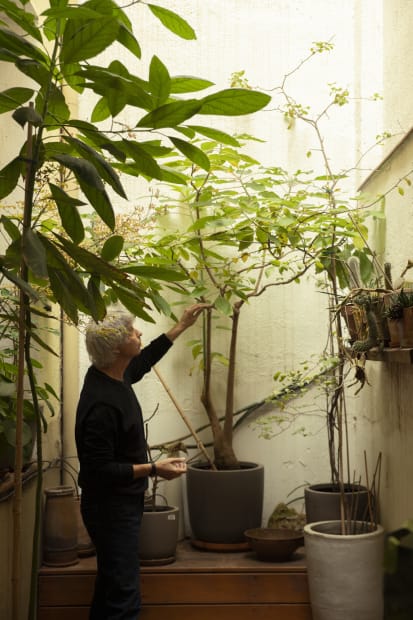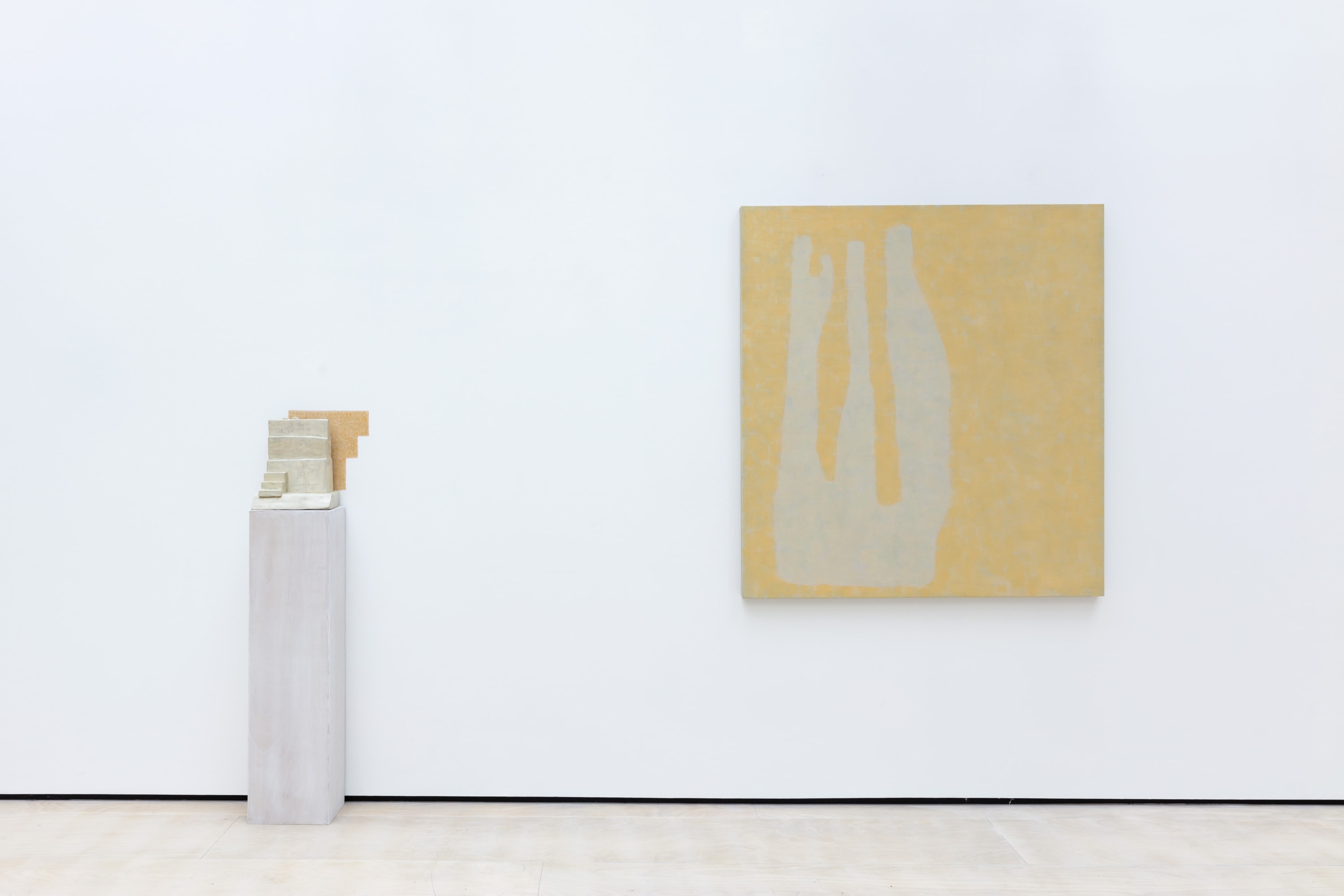-
Alejandro Corujeira | La luz fugaz
17 November, 2023 - 19 January, 2024 -
“The rose is without ‘why’; it blooms simply because it blooms. It pays no attention to itself, nor does it ask whether anyone sees it.”- Angelus Selesius
-
 Installation view, Alejandro Corujeira | La luz fugaz (Fleeting light), Cecilia Brunson Projects. Photography by Lucy Dawkins
Installation view, Alejandro Corujeira | La luz fugaz (Fleeting light), Cecilia Brunson Projects. Photography by Lucy Dawkins -
Cecilia Brunson Projects is pleased to present La luz fugaz (Fleeting light), the gallery’s third solo exhibition by Alejandro Corujeira (b. 1961, Argentina), featuring a new series of paintings produced in the last year. Created following a period the artist spent in a monastery, this new body of work emerges from a point of intuition and absence of thought, forming organically and through a trained control over the subtleties of colour and translucency of paint. The paintings are an invitation to a meditative process, as our eyes calibrate to this near invisibility, as if adjusting to a new light.
-
 Alejandro Corujeira in his Madrid studio. Photography by César Segarra
Alejandro Corujeira in his Madrid studio. Photography by César Segarra -
-
-
The paintings are formed of layers of diaphanous colour, from which nebulous shapes - sometimes suggestive of botanical, microbial or spirit-like bodies - appear out of the canvas, better read as passing shadows or tricks of the light than as anything concrete. Delicate and almost illusory, they approach a point of absolute abstraction. The effect is synaesthetic; visual elements such as form and colour seem subordinate to the sense of quiet and stillness achieved.
-
 Alejandro Corujeira, El universo [The universe], 2023, acrylic on linen, 170 x 200 cm (66 7/8 x 78 3/4 in)
Alejandro Corujeira, El universo [The universe], 2023, acrylic on linen, 170 x 200 cm (66 7/8 x 78 3/4 in) -
-
 Alejandro Corujeira in his Madrid studio. Photography by César Segarra
Alejandro Corujeira in his Madrid studio. Photography by César Segarra -
-
"There are several verses by Angelus Silesius that clearly articulate the idea I mentioned above: “The rose is without ‘why’; it blooms simply because it blooms. It pays no attention to itself, nor does it ask whether anyone sees it.” It is also true that for the images to come alive, to awaken, they require an act of generosity: a viewer that surrenders to them, submitting their soul and emotions. Agnes Martin, in a similar vein, wrote, “When I think of art, I think of beauty. Beauty is the mystery of life. It is not in the eye, it is in the mind. […] All human knowledge is useless in art work.” This is why I often say that I would like the person who approaches my work to do so with silent eyes, without too much prior information.”
-
Alejandro Corujeira’s artistic trajectory over more than thirty years has demonstrated the lyrical potential of painterly abstraction. With roots in the universal constructivism of Joaquín Torres-Garcia, a pioneering Uruguayan artist who created an alternate narrative of modernist abstraction based on pre-Columbian idioms, Corujeira gradually moved away from the regionalist sensibility of his early works to embrace a fiercely autonomous practice inspired by an abundant array of eclectic and diverse references: the tapestries and prints of Anni Albers, influenced by Andean and Mesoamerican textiles; Brice Marden and Mark Tobey’s painterly interpretations of Eastern calligraphy; the poet Paul Celan’s interrogation of language and loss; the neumes of premodern musical notation, to name only a few.
In this exhibition, the paintings are displayed alongside a selection of sculptures made early in the artist’s career in the 1990s. The influences at the root of Corujeira’s practice are clear here.
-
 Left: Hacia el cielo [Towards the sky], 1999, polychrome wood, 30 x 25 x 17 cm (11 3/4 x 9 7/8 x 6 3/4 in). Right: Empatía [Empathy], 2022, acrylic on linen, 130 x 120 cm (51 1/8 x 47 1/4 in)
Left: Hacia el cielo [Towards the sky], 1999, polychrome wood, 30 x 25 x 17 cm (11 3/4 x 9 7/8 x 6 3/4 in). Right: Empatía [Empathy], 2022, acrylic on linen, 130 x 120 cm (51 1/8 x 47 1/4 in) -
“There are certainly places with a particular energy that one can connect with and that are conducive to creativity. Before initiating my studies in fine arts, I travelled several times to the Andean region of northern Argentina: there I found a different way of understanding the world. I was initially interested in the forms I saw in ceramics, textiles, and objects, but then I gradually tried to understand how these forms were generated and how they were related to the thought and way of life there. The result of all those trips are the sculptural works presented in this exhibition, which were made in the early 1990s but never exhibited until now.”
-
-

Alejandro Corujeira
Hacia el cielo [Towards the sky], 1999
Polychrome wood30 x 25 x 17 cm (11 3/4 x 9 7/8 x 6 3/4 in)


![Alejandro Corujeira Latidos [Beats], 2022 Acrylic on linen 45 x 30 cm 17 3/4 x 11 3/4 in](https://artlogic-res.cloudinary.com/w_600,c_limit,f_auto,fl_lossy,q_auto/artlogicstorage/cbprojects/images/view/ad0d9b0d98f8b0aa771a68f8bc795521j.jpg)
![Alejandro Corujeira El viento [The wind], 2023 Acrylic on linen 40 x 40 cm 15 3/4 x 15 3/4 in](https://artlogic-res.cloudinary.com/w_600,c_limit,f_auto,fl_lossy,q_auto/artlogicstorage/cbprojects/images/view/8f8e1828c2238462e676f38a5f3ecc42j.jpg)
![Alejandro Corujeira El agua [The water], 2022 Acrylic on linen 40 x 40 cm 15 3/4 x 15 3/4 in](https://artlogic-res.cloudinary.com/w_600,c_limit,f_auto,fl_lossy,q_auto/artlogicstorage/cbprojects/images/view/fa42b2e53eb33b5a86fc7107ed2c9891j.jpg)
![Alejandro Corujeira Expansión [Expansion], 2022 Acrylic on linen 40 x 30 cm 15 3/4 x 11 3/4 in](https://artlogic-res.cloudinary.com/w_600,c_limit,f_auto,fl_lossy,q_auto/artlogicstorage/cbprojects/images/view/c47685b03b42d84310371dc266ce2f6aj.jpg)
![Alejandro Corujeira El inicio [The beginning], 2022 Acrylic on linen 40 x 40 cm 15 3/4 x 15 3/4 in](https://artlogic-res.cloudinary.com/w_600,c_limit,f_auto,fl_lossy,q_auto/artlogicstorage/cbprojects/images/view/6cdf1f3c0aa52bb5d946d1d9d676c279j.jpg)
![Alejandro Corujeira Anunciación I [Annunciation I], 2022 Acrylic on canvas 60 x 50 cm 23 5/8 x 19 3/4 in](https://artlogic-res.cloudinary.com/w_600,c_limit,f_auto,fl_lossy,q_auto/artlogicstorage/cbprojects/images/view/0b27a0b07f323dbfad72b4e888f19e06j.jpg)




![Alejandro Corujeira Máscara plaza [Plaza mask], 1999 Polychrome wood 28 x 20 x 15 cm 11 x 7 7/8 x 5 7/8 in](https://artlogic-res.cloudinary.com/w_600,c_limit,f_auto,fl_lossy,q_auto/artlogicstorage/cbprojects/images/view/88265fcc49cf254c659680d9994a98bbj.jpg)
![Alejandro Corujeira Amarrador solar [The sun's clasp], 1993 Ceramic and polychrome wood 33 x 18 x 16 cm 13 x 7 1/8 x 6 1/4 in](https://artlogic-res.cloudinary.com/w_600,c_limit,f_auto,fl_lossy,q_auto/artlogicstorage/cbprojects/images/view/5b6554172a4f21308eb94d035ef08b5bj.jpg)
![Alejandro Corujeira Pregunta [Question], 1999 Polychrome wood 22 x 24 x 7 cm 8 5/8 x 9 1/2 x 2 3/4 in](https://artlogic-res.cloudinary.com/w_600,c_limit,f_auto,fl_lossy,q_auto/artlogicstorage/cbprojects/images/view/757a88f155cc035a528cabe086255762j.jpg)
